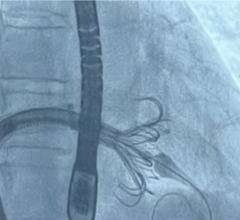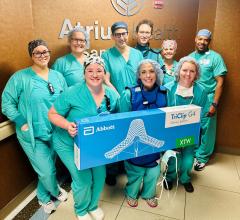
March 25, 2015 — A new expert consensus paper released by a coalition of cardiovascular organizations provides guidance on transcatheter pulmonic valve replacement (tPVR) for children and adults who were previously treated for congenital heart disease (CHD). The paper was jointly issued by the Society for Cardiovascular Angiography and Interventions (SCAI), American Association for Thoracic Surgery (AATS), American College of Cardiology (ACC) and The Society of Thoracic Surgeons (STS).
Pulmonary valve replacement may be necessary in patients who have had certain types of CHD repaired with reconstruction of the right ventricular outflow tract (RVOT), an area of the heart that carries blood out of the right ventricle. As patients with CHD live longer than they did in the past, dysfunction of the repair can occur over time. In the past, these patients would require a repeat open-heart surgery. Today, tPVR offers a less invasive option for many patients.
"Transcatheter valve treatments are allowing us to offer less invasive options to patients who were previously treatable only with open-heart surgery, or may not have been eligible for treatment at all," said Ziyad M. Hijazi, M.D., MPH, FACC, MSCAI, chair of the writing committee, acting chief medical officer and chairman of the Department of Pediatrics at Sidra Medical and Research Center in Doha, Qatar. "These procedures are complementing standard surgical approaches, allowing physicians to provide greater options for our patients."
As treatment advances, cardiologists and surgeons have the opportunity to collaborate in determining the best treatment option for each patient. The consensus paper stresses that tPVR treatment recommendations should be made by a heart team consisting of interventional cardiologists, cardiac surgeons, noninvasive cardiologists, and cardiac anesthesiologists and radiologists.
"There is strong consensus that these new valve therapies should be performed under the guidance of a multidisciplinary heart team, involving both interventional cardiologists and surgeons," said Hijazi. "Increasing evidence shows a team-based approach provides the greatest quality care for patients with complex heart disease, including patients considering tPVR."
The paper further recommends that institutions offering tPVR perform at least 150 congenital/structural catheterization procedures per year, including 100 that are interventional, as well as 100 open-heart congenital surgical procedures. Institutions should have the heart-lung bypass support known as extracorporeal membrane oxygenation (ECMO); echocardiography, cardiac computed tomography (CT) and cardiac magnetic resonance imaging (MRI) imaging capabilities; a cardiovascular cath lab; and hemodynamic evaluation. Additionally, institutions should participate in a national registry. Because tPVR is a new treatment option, the committee stressed the importance of continuing to collect data on the procedure, including total numbers of tPVR in the United States and numbers of procedures by operator and institution.
Physicians performing tPVR should perform at least 100 interventional cases per year, including 50 congenital/structural interventional cases. They should have experience with balloon valvuloplasty as well as stenting within pulmonary arteries and RVOT. The paper also recommends physicians attend peer-to-peer training and a simulated case if available. The first three procedures performed should be under the guidance of an experienced physician.
"As physician experience with tPVR increases over time, complication rates are declining significantly, reflecting the importance of experience in improving patient outcomes," said Hijazi.
A committee of cardiac surgeons and interventional cardiologists developed the recommendations, which were created to help physicians and hospitals offer consistent and appropriate care to tPVR patients. The new paper is the third in a series of expert consensus papers for hospitals and physicians performing transcatheter valve procedures. The first two papers discussed aortic and mitral valve procedures.
The document, titled "Operator & Institutional Requirements for Transcatheter Valve Repair and Replacement, Part III - Pulmonic Valve," will simultaneously e-publish in Catheterization and Cardiovascular Interventions (CCI), Journal of Thoracic and Cardiovascular Surgery (JTCVS), Journal of the American College of Cardiology (JACC) and The Annals of Thoracic Surgery.
For more information: www.scai.org, www.aats.org, www.acc.org, www.sts.org


 March 31, 2025
March 31, 2025 








